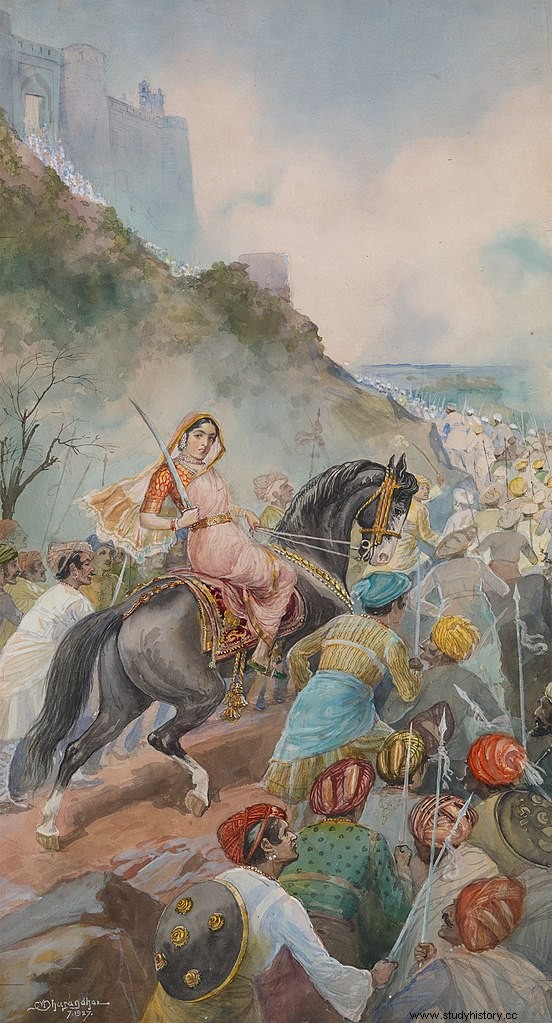Regent of the Marathi Empire in India, Tarabai Mohite (1675 – 1761), renowned for her courage, is known for her armed resistance against the Mughal occupation of her territories.
As close as possible to the royal family

Tarabai was born in 1675 within the Marathi Empire in northern India, a state formally created the previous year following a rebellion against the Mughal Empire which dominates the region. Coming from the Mohite family clan, Tarabai is the daughter of General Hambirao Mohite, military leader of the army of Chhatrapati (Emperor) Shivaji Bhonsale I. The two families are also linked by marriage:Soyarabai, sister of Hambirao and aunt of Tarabai , is one of the Emperor's wives.
In her youth, Tarabai was introduced to cavalry, archery, the handling of weapons, but also military strategy and diplomacy. The times were turbulent:the Mughal Empire, led by Emperor Aurangzeb, sought to crush the revolt while Shivaji I extended the territories and spheres of influence of the Maratha Empire
Reign of Rajaram
Tarabai marries Shivaji Bhonsale I and Soyarabai's youngest son, his cousin Rajaram. Rajaram will have three wives and three sons, including Shivaji with Tarabai. On the death of Shivaji I, his eldest son Sambhaji acceded to the throne. Captured by the Mughal army, the latter was put to death in 1689; his wife Yesubai and his son Shahu are kept as hostages. Rajaram then takes over from his half-brother and becomes Chhatrapati.
As eventful as that of his father, Rajaram's reign was marked by the conflict with the Mughal Empire, which occupied territories of the Marathi Empire. After his coronation in Raigad in March 1689, Rajaram was thus forced to disguise himself to flee the Mughal army which occupied the region. However, it was of a lung disease that he died in March 1700. Tarabai immediately proclaimed himself regent in the name of his four-year-old son Shivaji II.
Commander of the Marathi Forces
As regent, 25-year-old Tarabai Mohite takes control of the armies and leads the conflict against the Mughal Empire and its Emperor Aurangzeb. The Mughal chronicler Khafi Khan writes of this period:“[The Mughals thought] that it would not be difficult to overthrow two young children and a helpless wife. They thought the enemy was weak, despicable, and defenseless. But Tarabai, wife of Rajaram, showed great strength in command and government, and day by day the war spread and the power of the Marathas increased. »
Tarabai is proving gifted in military strategy, and competent both on and off the battlefield. A good rider, she personally led the fight against the Mughals until she took the lead in the assaults. Outside of battle, she travels the Marathi Empire, asserting her authority, forging alliances, corrupting enemy officers. The Mughal officer Bhimsen will indicate in his memoirs that she is a stronger leader than her husband.
In 1706, Tarabai was briefly captured by Mughal forces, but she managed to escape by bribing a soldier with a luxurious piece of jewelry. During her regency, she held the Marathi Empire together, protected it from Mughal repression and repelled the enemy.
A rival court
In 1707, Aurangzeb, aged 88, died. To prevent the Maratha Empire from taking advantage of a temporary power vacuum and to divide its forces, the Mughals then decided to release Shahu, son of the previous emperor Sambhaji and nephew of Tarabai, who had been detained for 18 years. The scheme works:Shahu claims the throne, which he would have inherited upon his father's death had he not been captured. After a brief conflict, Shivaji II is deposed in favor of his cousin.
Tarabai then decides to set up a rival court in Kolhapur. Shivaji II reigned briefly as Raja of Kolhapur, from 1710 to 1714. He was then deposed a second time by another wife of his father, Rajasbai, who installed his son Sambhaji II on the throne. Tarabai and his son are imprisoned. Shivaji II died of illness in 1726.
Conflict with Peshwa Balaji Baji Rao
In 1730, Tarabai Mohite reconciled with Shahu I and settled in Satara. Without exercising political power, but not quite without influence. During the last years of Shahu I's reign, she introduces him to a man named Rajaram, whom she indicates is her grandson:a son of her son, hidden at birth to protect him from Shambhaji, and raised by a soldier's wife.
Shahu adopts the young man. Upon his death in 1749, Rajaram II acceded to the throne. Tarabai then urges him to dismiss the Peshwa (Prime Minister) Balaji Baji Rao, who has gone on campaign. Rajaram II refuses and Tarabai has him imprisoned, claiming he is not his grandson but an impostor. The former regent allies herself with a noblewoman but their troops are defeated; Tarabai is finally forced to admit defeat and sign peace. Although she persists in saying that Rajaram II is not her grandson, the man retains the throne while the real power is exercised by the Peshwa Balaji Baji Rao.
Tarabai died in December 1761, at the age of 86. The same year which saw in January the defeat of the Marathi Empire against the Afghans of the Durrani Empire, during the battle of Pânipat. This decisive defeat marked the beginning of the decline of an empire that she had known how to maintain and protect.
